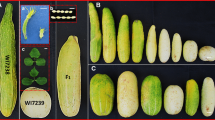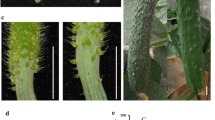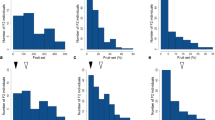Abstract
Key message
Quantitative Trait Loci (QTL) analysis of multiple populations in multiple environments revealed that the fsd6.2 locus, which includes the candidate gene Csgl3, controls high fruit spine density in natural cucumbers. GWAS identified a novel locus fsd6.1, which regulates ultra-high fruit spine density in combination with Csgl3, and evolved during cucumber domestication.
Abstract
Fruit spine density, a domestication trait, largely influences the commercial value of cucumbers. However, the molecular basis of fruit spine density in cucumber remains unclear. In this study, four populations were derived from five materials, which included three with low fruit spine density, one with high fruit spine density, and one with ultra-high fruit spine density. Fruit spine densities were measured in 15 environments over a span of 6 years. The distributions were bimodal suggesting that fruit spine density is controlled by a major-effect QTL. QTL analysis determined that the same major-effect QTL, fsd6.2, is present in four populations. Fine map** indicated that Csgl3 is the candidate gene at the fsd6.2 locus. Phylogenetic and geographical distribution analyses revealed that Csgl3 originated from China, which has the highest genetic diversity for fruit spine density. One novel minor-effect QTL, fsd6.1, was detected in the HR and HP populations derived from the cross between 65G and 02245. In addition, GWAS identified a novel locus that colocates with fsd6.1. Inspection of a candidate region of about 18 kb in size using pairwise LD correlations, combined with genetic diversity and phylogenetic analysis of fsd6.1 in natural populations, indicated that Csa6G421750 is the candidate gene responsible for ultra-high fruit spine density in cucumber. This study provides new insights into the origin of fruit spine density and the evolution of high/ultra-high fruit spine density during cucumber domestication.







Similar content being viewed by others
References
Bloomer RH, Lloyd AM, Symonds VV (2014) The genetic architecture of constitutive and induced trichome density in two new recombinant inbred line populations of Arabidopsis thaliana: phenotypic plasticity, epistasis, and bidirectional leaf damage response. BMC Plant Biol 14:220–222
Bo KL, Ma Z, Chen JF, Weng Y (2015) Molecular map** reveals structural rearrangements and quantitative trait loci underlying traits with local adaptation in semi-wild **shuangbana cucumber (Cucumis sativus L. var. xishuangbannanesis Qi et Yuan). Theor Appl Genet 128:25–39
Bo KL, Wang H, Pan YP, Behera TK, Pandey S, Wen CL, Wang YH, Simon PW, Li YH, Chen JF, Weng Y (2016) SHORT HYPOCOTYL1 encodes a SMARCA3-Like chromatin remodeling factor regulating elongation. Plant Physiol 172:1273–1292
Broman KW, Wu H, Sen S, Churchill GA (2003) R/qtl: QTL map** in experimental crosses. Bioinformatics 19:889–890
Call AD, Wehner TC (2010) Gene list for cucumber. Cucurbit Genet Coop Rpt 33–34:69–103
Cavagnaro PF, Senalik DA, Yang LM, Simon PW, Harkins TT, Kodira CD, Huang SW, Weng Y (2010) Genome-wide characterization of simple sequence repeats in cucumber (Cucumis sativus L.). BMC Genom 11:569
Chen C, Liu M, Jiang L, Liu X, Zhao J, Yan S (2014) Transcriptome profiling reveals roles of meristem regulators and polarity genes during fruit trichome development in cucumber (Cucumis sativus L.). J Exp Bot 65:4943–4958
Chen CH, Yin S, Liu XW et al (2016) The WD-repeat protein CsTTG1 regulates fruit wart formation through interaction with the Homeodomain–Leucine Zipper I protein Mict1. Plant Physiol 171:1156–1168
Cui JY, Miao H, Ding LH et al (2016) A new glabrous gene (csgl3) identified in trichome development in cucumber (Cucumis sativus L.). PLoS ONE 11:e0148422
Fanourakis NE, Simon PW (1987) Analysis of genetic linkage in the cucumber. J Hered 78:238–242
Gan Y, Kumimoto R, Liu C, Ratcliffe O, Yu H, Broun P (2006) GLABROUS INFLORESCENCE STEMS modulates the regulation by gibberellins of epidermal differentiation and shoot maturation in Arabidopsis. Plant Cell 18:1383–1395
Gan Y, Liu C, Yu H, Broun P (2007) Integration of cytokinin and gibberellin signaling by Arabidopsis transcription factors GIS, ZFP8 and GIS2 in the regulation of epidermal cell fate. Development 134:2073–2081
Grebe M (2012) The patterning of epidermal hairs in Arabidopsis—updated. Curr Opin Plant Biol 15:31–37
Guan Y (2008) Map** and cloning of related gene for fruit spines formation in cucumber. Ph.D. Thesis. Shanghai Jiao Tong University (in Chinese)
Hülskamp M (2004) Plant trichomes: a model for cell differentiation. Nat Rev Mol Cell Biol 5:471–480
Hülskamp M, Schnittger A, Folkers U (1999) Pattern formation and cell differentiation: trichomes in Arabidopsis as a genetic model system. Int Rev Cytol 186:147–178
Kenneth JL, Thomas DS, Livak KJ, Schmittgen TD (2001) Analysis of relative gene expression data using real-time quantitative PCR and the 2−ΔΔCt method. Methods 25:402–408
Li YH, Yang LM, Pathak M, Li DW, He XM, Weng Y (2011) Fine genetic map** of cp: a recessive gene for compact (dwarf) plant architecture in cucumber, Cucumis sativus L. Theor Appl Genet 123:973–983
Li YH, Wen CL, Weng YQ (2013) Fine map** of the pleiotropic locus B for black spine and orange mature fruit color in cucumber identifies a 50 kb region containing a R2R3-MYB transcription factor. Theor Appl Genet 126:2187–2196
Li Q, Cao C, Zhang C, Zheng S, Wang Z, Wang L, Ren Z (2015) The identification of Cucumis sativus Glabrous 1 (CsGL1) required for the formation of trichomes uncovers a novel function for the homeo domain leucine zipper I gene. J Exp Bot 66:2515–2526
Liu XW, Bartholomew E, Cai YL, Ren HZ (2016) Trichome-related mutants provide a new perspective on multicellular trichome initiation and development in cucumber (Cucumis sativus L.). Front. Plant Sci 7:1187
Machado A, Wu Y, Yang Y, Llewellyn DJ, Dennis ES (2009) The MYB transcription factor GhMYB25 regulates early fibre and trichome development. Plant J 59:52–62
Miao H, Zhang SP, Wang XW, Zhang ZH, Li M, Mu SQ, Cheng ZC, Zhang RW, Huang SW, **e BY, Fang ZY, Zhang ZX, Weng Y, Gu XF (2011) A linkage map of cultivated cucumber (Cucumis sativus L.) with 248 microsatellite marker loci and seven genes for horticulturally important traits. Euphytica 172:167–176
Pan YP, Bo KL, Cheng ZH, Weng YQ (2015) The loss-of-function GLABROUS 3 mutation in cucumber is due to LTR-retrotransposon insertion in a class IV HD-ZIP transcription factor gene CsGL3 that is epistatic over CsGL1. BMC Plant Biol 15:1–15
Pan YP, Qu SP, Bo KL, Gao ML, Haider KR, Weng YQ (2017) QTL map** of domestication and diversifying selection related traits in round-fruited semi-wild **shuangbanna cucumber (Cucumis sativus, L. var. xishuangbannanesis). Theor Appl Genet 130:1531–1548
Pattanaik S, Patra B, Singh SK, Yuan L (2014) An overview of the gene regulatory network controlling trichome development in the model plant, Arabidopsis. Front Plant Sci 5:259–266
Qi JJ, Liu X, Shen D et al (2013) A genomic variation map provides insights into the genetic basis of cucumber domestication and diversity. Nat Genet 45:1510–1515
Ren Y, Zhang Z, Liu J, Staub JE, Han Y, Cheng Z, Li X et al (2009) An integrated genetic and cytogenetic map of the cucumber genome. PLoS ONE 4:e5795
Schellmann S, Hülskamp M (2005) Epidermal differentiation: trichomes in Arabidopsis as a model system. Int J Dev Biol 49:579–584
Tian HN, Wang XL, Guo HG et al (2017) NTL8 regulates trichome formation in arabidopsis by directly activating R3 MYB genes TRY and TCL1. Plant Physiol 174:2363–2375
Turner SD (2014) qqman: an R package for visualizing GWAS results using QQ and Manhattan plots. bioRxiv, 005165. http://dx.doi.org/10.1101/005165
Vakalounakis DJ (1992) Heart leaf, a recessive leaf shape markers in cucumber: linkage with disease resistance and other traits. J Hered 83:217–220
Walters SA, Shetty NV, Wehner TC (2001) Segregation and linkage of several genes in cucumber. J Am Soc Hortic Sci 126:442–450
Wang YL, Nie JT, Chen HM, Guo CL, Pan J, He HL, Pan JS, Cai R (2016) Identification and map** of Tril, a homeodomain-leucine zipper gene involved in multicellular trichome initiation in Cucumis sativus. Theor Appl Genet 129:305–316
Weng Y, Colle M, Wang Y, Yang L, Rubinstein M, Sherman A, Ophir R, Grumet R (2015) QTL map** in multiple populations and development stages reveals dynamic QTL for fruit size in cucumbers of different market classes. Theor Appl Genet 128:1747–1763
**, genetic diversity, and transcriptome profiling reveals that the auxin transporter gene ns plays an important role in cucumber fruit spine development. Theor Appl Genet. https://doi.org/10.1007/s00122-018-3074-x
Xue XY, Zhao B, Chao LM, Chen DY, Cui WR, Mao YB, Wang LJ, Chen XY (2014) Interaction between two timing microRNAs controls trichome distribution in Arabidopsis. PLoS Genet 10:e1004266
Yang CX, Li HX, Zhang JH, Luo ZD, Gong PJ, Zhang CJ, Li JH, Wang TT, Zhang YY, Lu YE, Ye ZB (2011) A regulatory gene induces trichome formation and embryo lethality in tomato. Proc Natl Acad Sci USA 108:11836–11841
Yang LM, Koo DH, Li Y, Zhang X, Luan F, Havey MJ, Jiang J, Weng Y (2012) Chromosome rearrangements during domestication of cucumber as revealed from high-density genetic map** and draft genome assembly. Plant J 71:895–906
Yang X, Zhang W, He H et al (2014) Tuberculate fruit gene Tu encodes a C2H2 zinc finger protein that is required for the warty fruit phenotype in cucumber (Cucumis sativus L.). Plant J 78:1034–1046
Yang S, Cai YL, Liu XW, Dong MM, Zhang YQ, Chen SY et al (2018) Csmyb6-cstry module regulates fruit trichome initiation in cucumber. J Exp Bot 69:1887–1902
Yuan XJ, Pan JS, Cai R, Guan Y, Liu LZ, Zhang WW, Li Z, He LH, Zhang C, Si LT, Zhu LH (2008) Genetic map** and QTL analysis of fruit and flower related traits in cucumber (Cucumis sativus L.) using recombinant inbred lines. Euphytica 164:473–491
Zhang HY, Wang LN, Zheng SS et al (2016a) A fragment substitution in the promoter of CsHDZIV11/CsGL3 is responsible for fruit spine density in cucumber (Cucumis sativus L). Theor Appl Genet 129:1289–1301
Zhang SP, Liu SL, Miao H et al (2016b) Molecular map** and candidate gene analysis for numerous spines on the fruit of cucumber. J Hered 107:471–477
Zhao JL, Pan JS, Guan Y, Zhang WW, Bie BB, Wang YL, He HL, Lian HL, Cai R (2015) Micro-trichome as a class I homeodomain-leucine zipper gene regulates multicellular trichome development in Cucumis sativus. J Integr Plant Biol 57:925–935
Acknowledgements
We thank Dr. Graham Collins, formerly of the University of Adelaide, South Australia, for English editing of the manuscript. We thank LetPub for its linguistic assistance during the preparation of this manuscript. This work was supported by the National Key Research and Development Program of China [2016YFD0101705], the Earmarked Fund for Modern Agro-industry Technology Research System [CARS-25], Science and Technology Innovation Program of the Chinese Academy of Agricultural Science (CAAS-ASTIP-IVFCAAS), the National Natural Science Foundation of China (31572146), and the Key Laboratory of Biology and Genetic Improvement of Horticultural Crops, Ministry of Agriculture, China.
Author information
Authors and Affiliations
Contributions
KB performed the experiments, analyzed experimental data, and wrote the paper. HM helped analyze data and collected the data for LM2012S and LM2012F. MW collected the data for LM2013S and LM2013F. XX collected the data for YR2014F, YR2015S, and YR2015F. ZS collected the data for CG lines. QX and LS collected the data for HR2016S, HR2016F, HP2016S, and HP2016F. WW and SW collected the data for HR2017S, HR2017F, HP2017S, and HP2017F. SZ and XG provided valuable research design. All authors read and approved the final manuscript.
Corresponding authors
Ethics declarations
Conflict of interest
The authors declare that they have no conflict of interest.
Ethical standards
The authors declare that this study complies with the current laws of the countries in which the experiments were performed.
Additional information
Communicated by Michael J. Havey.
Electronic supplementary material
Below is the link to the electronic supplementary material.
Rights and permissions
About this article
Cite this article
Bo, K., Miao, H., Wang, M. et al. Novel loci fsd6.1 and Csgl3 regulate ultra-high fruit spine density in cucumber. Theor Appl Genet 132, 27–40 (2019). https://doi.org/10.1007/s00122-018-3191-6
Received:
Accepted:
Published:
Issue Date:
DOI: https://doi.org/10.1007/s00122-018-3191-6




